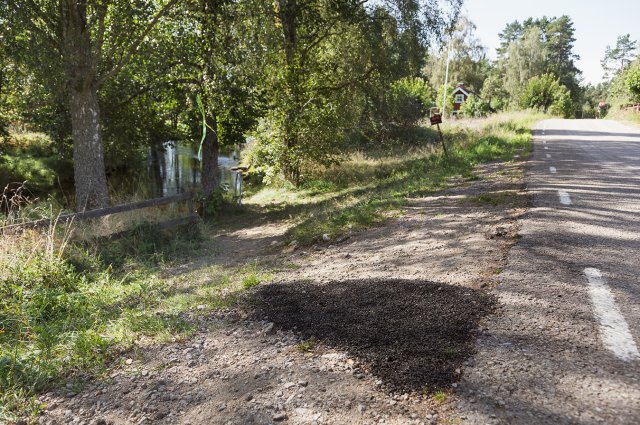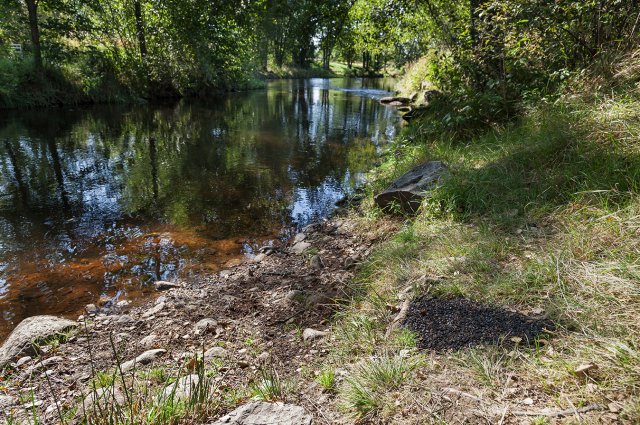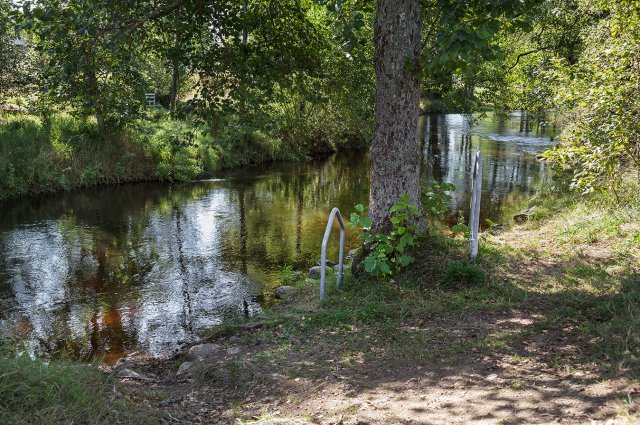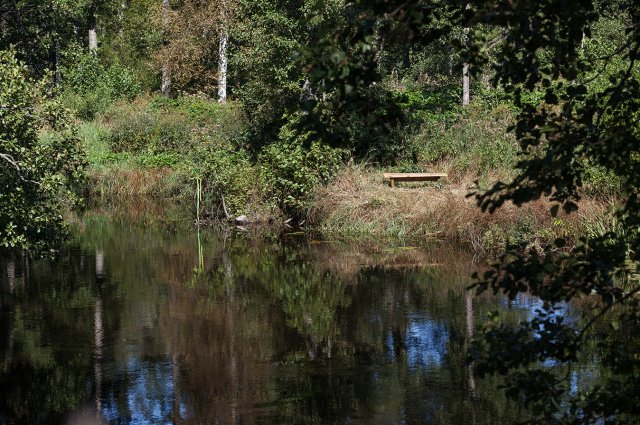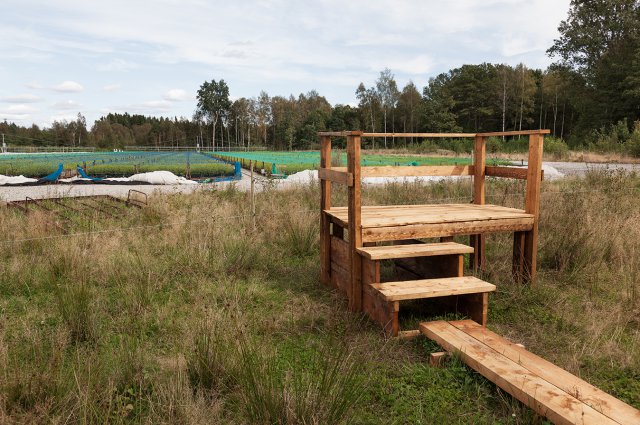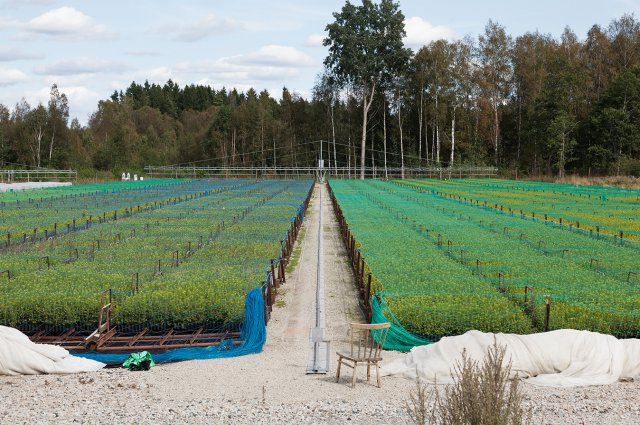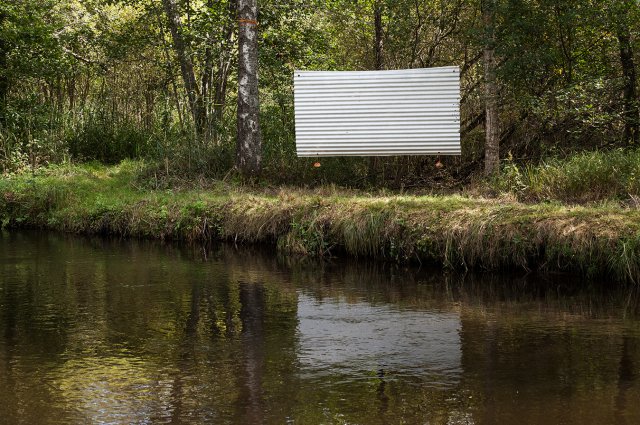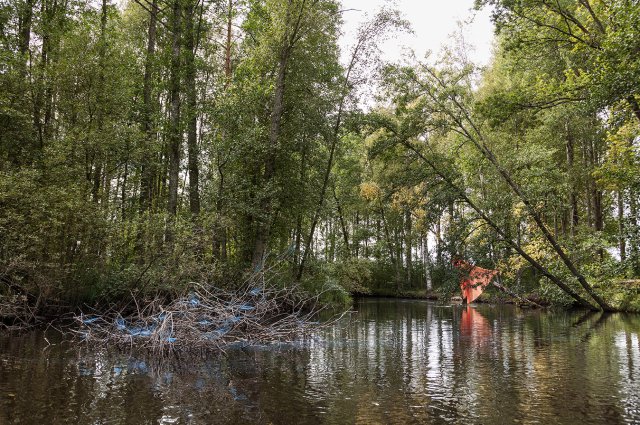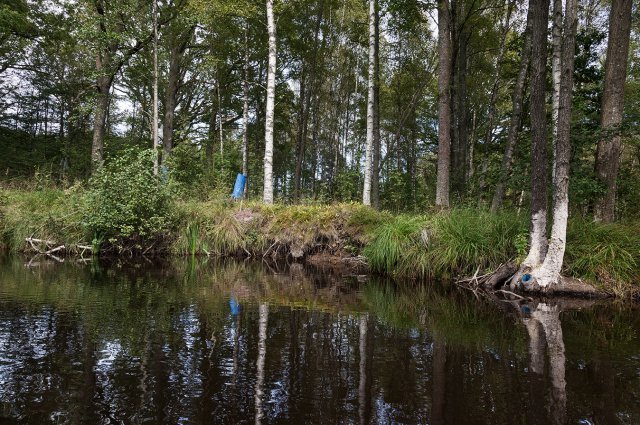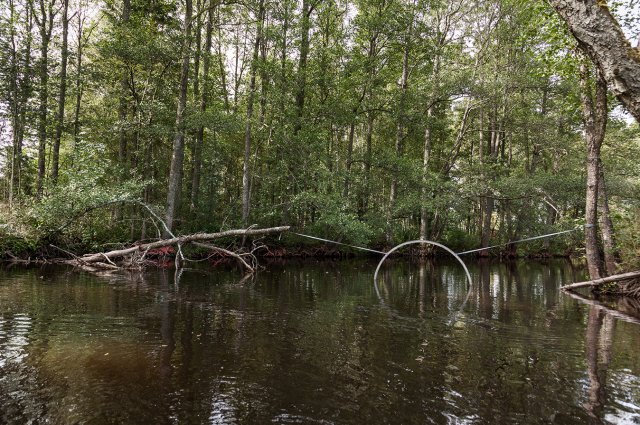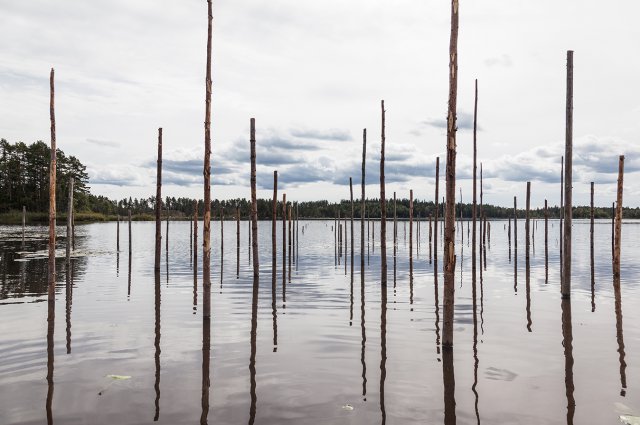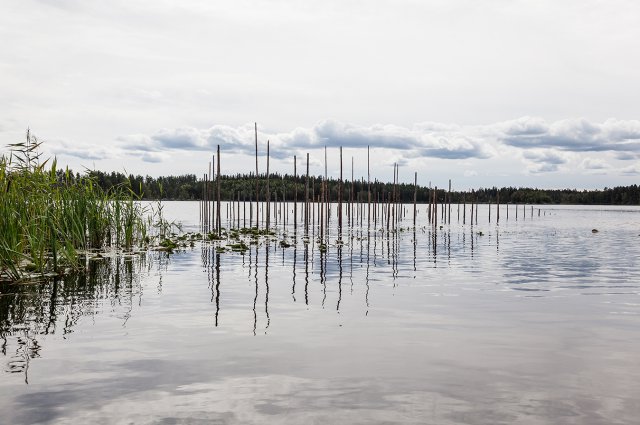by Lisa Rosendahl
If you venture into the forest, you are likely to reemerge transformed in one way or another. Every storyteller, outdoors person and paper mill baron knows this. The forest supplies us with raw materials, personal insights and encounters with nature. It is a well-worn metaphor for that thorny journey called life, and a very real necessity for an abundance of organisms, from microscopic spores to multinational corporations. The adventurous journey through the forest is perhaps also the archetype for linear storytelling, the narrative form which long dominated our western culture: one begins at its outer edges, disappears in among the trees to be surrounded by one’s fate, only to a few camp fires, chapters or novels later see the trees grow sparse and have the story reach its conclusion. The forest is — like the street, the beach and the white cube — a generic idea and a fictive image as much as it is a specific place and reality.
The forest plays a central role in a Swedish context. It was, and is, one of the cornerstones of Swedish industry and therefore also of the modernization of the nation. The forest literally built the society while it at the same time paradoxically acquired the role as a place of retreat when society was becoming too intrusive. Today the forest as cultural reflection and national myth is still significant, even if the landscape has been cultivated beyond recognition. The aesthetic of the million program [1] can be found in the homogenized trees standing in rectilinear rows across the entire country. Today, Swedish wilderness is simply an image we carry within us. And perhaps it was just then, when nature became an image, that modernity was born: the very idea of nature as wild and essentially different from the civilized human was a necessity in order for modern society to be able to develop at the pace that it did; if the idea of untamed nature had not been articulated the need for paved streets and rectangular blocks would have been less urgent. All signs now point to the fact that we have satisfied the production ideals of modernity and devastated any remaining evidence that there ever was anything but an eternally expanding society: according to the national atlas of Sweden there is no longer any forest in this country, only forestry.
Right now we are in the forest by the Ronneby River between Korrö and Bast Lake, where six cultural workers from different disciplines have been in residence for two weeks and have produced new work within the parameters of the project Residence-in-Nature. The area has been populated since the Stone Age and the river was an important route for ancient peoples. Here are also a plentitude of traces from what happened since: fields and land for grazing, small villages and modern communities, wind mills and saw mills, ore mining and charcoal production, furniture making and paper production, glassworks and tourism. It is a landscape rich with a cultural heritage, but in what way does contemporary art fit in?
The art works along Ronneby River have grown out of a relatively brief on-site production phase during which the artists have been in close dialogue with the environment, both physically and intellectually, and have drawn on it as material. The project is dissimilar from other instances where art meets nature, for example the sculpture park Wanås in Skåne, with large production budgets and permanent works, or the large-scale Land Art manifestations created in the U.S. in the 1960s and 70s. This exhibition, which is best experienced from a canoe, is temporary and relatively low-key. The production process is as important a component as the result. Instead of moving high-octane art into nature to create unexpected contrasts, my impression is that the participants instead have let the surroundings move into them and their way of working. The artists have adapted to the place in a variety of ways that highlight their respective approaches. Together they make the area visible as a public space, a term one doesn’t perhaps normally think of in relation to this picturesque, privately owned place.
The term public space in part connotes that a place should be accessible to all; we have a right to be there regardless of who owns the land and without in advance having to define what we will do there. The forest, through the legally defined “right to roam,” [2] is of course such a place. Here we can even pause for a moment, sit down or spend the night — and in which of our city’s streets or squares is one granted that privilege? But public space as a concept also connotes something else, often associated with the densely populated city: the prerequisite for a common experience shared by many and therefore the idea of the political. It is in public space that the distribution of power takes place within a democracy, and it is here that power is expressed: through urban planning, normative messages and behavior, or social attributes and choreographies. But it is also a space for discussion and critiques of power, a place for making public and shedding light on various issues and occurrences. Contemporary art grows out of this tradition. In the best case, to encounter art in the forest thereby encourages and challenges us to think critically and reflect on a place and our relationship to it. By being present here, art creates opportunities for conversations and new perspectives.
If you begin your canoe trip through the exhibition from the informational kiosk in Bro, the first work you will encounter is Lisa Torell’s Craft, Application and Protection. Torell has worked at the juncture where the public road ends and the forest begins, and has created a series of interventions along the slope down to the water. Legible as passage rather than as place, the area attests to the fact that no one normally pauses her for longer than necessary. Here, the experience of nature is not immersive: the road back to civilization is constantly making itself known, and traces on the ground and plant life attest to the fact that many do not feel that they need to be as careful here as they do further into the natural environment. Using asphalt, Torell has covered those patches worn most by visitors’ eagerness to enter the forest. Around the tree trunk that has born the brunt of the canoes she has installed protective galvanized metal tubes. Torell’s piece raises the question of where society ends and nature begins, but also ideas about what kind of aesthetic we find acceptable in different contexts.
The piece reinforces the transition between nature and culture, in part by literally arming the ground and tree with asphalt and steel, but also by directing our gazes to the idea that such a transition even exists. Visually, Torell’s intervention is contradictory, to say the least. On the one hand the matte steel tubes cue us to state-determined standards and legally regulated safety measures that are difficult to recognize as art when outside the gallery space. On the other hand, they remind us of an urban environment that is not compatible with the expectations of the nature we are entering. This makes the work feel quotidian and strange at the same time. There is a parallel here between our expectations of nature and of art. As one in nature often looks for wild beauty, the unplanned and the informal, art has since modernism been expected to fill a similar function as a contrast to mundane society, and has been seen as representative of the authentic in an increasingly artificial existence. The modernist mindset in this way generated a series of binaries that obscured more than they revealed: the idea of nature as untamed was cemented while at the same time humankind intensified its exploitation of the environment to the point that any untouched nature can no longer be said to exist. Similarly, art and the artist were assigned the roles of bearers of authenticity even though a work of art, like every attempt at representation, builds on the very possibility of artificiality. In this contradictory way we can in part understand art as the equivalent of nature, but also as its opposite.
The title of Torell’s piece opens the possibility for additional reinterpretations of established terms and binaries. Here I am thinking primarily of the word handicraft which has a strange ring in relation to the industrial materials and labor processes the work consists of. But in light of the fact that we are said to live in the Anthropocene, the geological era when humankind’s interventions in nature have had such an extensive impact that they can be equated with natural forces, it is perhaps not so strange after all. From that perspective the difference between traditional crafts, asphalt paving and environmental destruction is not so great: the source is still humanity. In addition, the relationship between craft and industry is causal: the crafts environment around Korrö with a wind mill, saw mill and tannery from the 1700s is of course an early version of today’s heavy industry. It will not be long before today’s industry has become tomorrow’s artisanship. Johanna Gustavsson Fürst’s The Delighted Spectators Quietly Viewed the Remarkable Spectacle also engages with our expectations of the encounter with nature. The piece can be found in two sites. One site is indicated by two wood benches placed on either side of the stream. At first glance the benches appear idyllically situated by the leafy edge of the stream; perfect spots for a much-needed break from paddling, with an opportunity to pause and take in the beautiful surroundings. But upon closer examination one realizes that the benches’ placement is even more strategic. Instead of directing our attention to the picturesque surroundings, the resting spots direct our attention to what lies just beyond the verdant river’s edge, which are the warehouses and mill of Lars Carlsson’s Wood Products, Inc. The company clears, processes and sells timber from nearby forests, and has also produced and donated the material for Gustavsson Fürst’s benches. By treating the buildings as a part of the environment rather than as something we’d rather ignore in our pursuit of a satisfying experience of nature, Gustavsson Fürst reminds us that we are in the middle of an industrial landscape where timber and tourism are hard cash. We are also reminded that one depends on the other: the very nature that most people today consider attractive and hikable is not virgin forest, but instead consists of forests that have been thinned and cultivated over the years creating a passable and variegated scenery. Similarly, mass tourism emerged as a phenomenon alongside industrialization, when leisure time became a popular concept and the working population had means that extended beyond everyday needs.
A few hundred meters away by the opening to Bast Lake is another component of the same piece. We are encouraged to dock and wander into the forest. The tier of fully grown trees, however, turns out to only be a few meters deep. Beyond awaits a large-scale nursery. We follow Gustavsson Fürst’s wooden walk-way toa specially constructed viewing platform. Again the conceptual and actual components of the piece are one and the same: the platform is constructed out of the locally harvested pine it aims to highlight. The company Southern Forest Plants delivers more than 15 million forest plantings annually from their nursery in Flåboda. Infinite numbers of plantings of the exact same height stand in straight rows waiting to grow to the desired size and be planted by landowners around the country, to be cleared a few decades later. The sea of standardized plantings brings to mind the premise in Peter Tillberg’s painting Will You Be Profitable Little Friend? (1971–72) where equal parts listless and expectant schoolchildren look back at us from behind their rows of school desks. Gustavsson Fürst’s piece stages an abrupt contrast to the prospect of natural nature and becomes yet another reminder of how our gazes are often directed. Like the bulk of the trees we encounter in Swedish forests are planted, the paddling tourist’s sense of freedom follows a well-defined course. Gustavsson Fürst’s piece constitutes an elegantly interlocked unit where circuits of production and consumption are made visible, as are we in our roles as both fellow actors and spectators.
Discourse around the forest is usually about nature as livelihood or as landscape. It is rare that one speaks of it as culture. Caroline Ringskog Ferrada-Nolis’ sound piece Nature prompts us to question the idea of the natural and primordial by connecting it to its self-selected opposite, culture. “Why are you here in Sweden, in this forest?” asks a young female voice. “Where are you actually from? You’re not totally Swedish, right? I was thinking mostly that you’re pretty dark. Not black, but pretty dark. Are your parents from here?” The monologue highlights a situation which, despite the woman’s startling naiveté, perhaps can only be described as evil. The young woman delivers a series of statements about “immigrants” as such a matter of course that one sees that she considers it her given right to make declarations about the state of things. The position that she is the norm, the given, the natural, for the place she is in is so obvious that she is incapable of reflecting upon it no matter how much she reasons with herself. It is a completely uninhibited and normalized racism, unpleasantly amplified by her gentle tone and friendly attitude. When one travels through Sweden the road is most likely bordered by a natural landscape that emerged during the same period as Folkhemmet [3], when economic growth created an indomitable faith that everything would become better while the natural landscape was sacrificed for industry. The result is a landscape that can best be described as homogeneous and anonymous. Evenly green trees of the same variety and age stand in rows along the highways. If there is a community in the distance it is undetectable, and can only be suspected in advertisements for fast food restaurants that appear at the edge of the road at regular intervals. There are people here, somewhere, but one never lays eyes on them.
It is good to be reminded that this nature is in no way natural, but a cultural product that follows a specific aesthetic. It is surprisingly rare that this aesthetic is called into question. It is functional, instrumental, automatic. Connections between the homogenous landscape and the idea of nature as primordial are unpleasant, to say the least. Folkhemmet was not accessible to everyone; rather, it depended on a significant degree of exclusion. The Swedish landscape as a reflection of the soul of the people warrants critical self-reflection. As reality is presented today there is little space for biological diversity. The national parks boast of their authenticity, but how they are selected is highly questionable. According to the Swedish National Park Service, the national parks are “representative landscape types that are maintained in their natural condition, but they should also be beautiful or unique environments that can produce powerful encounters with nature.” Created with the purpose of conserving and representing the nation’s different archetypes it is presented as a given that only those environments that are beautiful are to be protected. Nature as concept is still deployed in different contexts to exclude or criminalize people: for their sexual orientation, gender or way of being. To invoke the “natural” as if it existed separate from culturally defined values is as preposterous as ignoring that it was humankind that invented the word nature. An ambivalence concerning the natural can once again be found in the title of Åsa Jungnelius’ piece, Landscape Painting, which should be understood as having dual meanings. The piece is a representation of a real image, at the same time that it is an actual landscape painting — Jungnelius has literally painted and modified the landscape. The installation extends along both sides of the river and a bit into the woods, and creates a field where the movement of the canoe and the form of the piece become one. An arch standing in the water forms a circular passage for the canoe as it does for one’s consciousness: half concrete metal, half reflection in the water. Space and image, reality and representation, romance and concretism, are linked together in a shared journey that at times makes the landscape appear magical and at other times makes it unattractive. Spider webs sprayed blue hang seductively like soft veils between tree trunks and point to a fairy tale landscape where anything can be possible. However, that very same blue color returns a bit further away in the form of rough plastic bags wrapped around cutdown trees. The color is typically used to mark trees ready to be cleared, the plastic bags are ubiquitous within the timber industry, the space we are transported through is a production unit while also a landscape, a tourist trade and place for romance and spirituality.
Jungnelius highlights what is already there, utilizes everyday materials in a divergent way, or adds the extraordinary as if it is a given. The piece creates a dramaturgy where the movement itself, the river’s flow and the direction of the gaze, is made evident and one suddenly detects the geometry in a pair of leaning trees or the river’s reflection in the water in a new way. We are moving through a painting. Green play dough frames the already verdant plant life, bright pink tree roots crawl at the water’s edge like fluorescent vegetation dripping with phosphorous. The different components create a force field where everything — what the artist has contributed as well as what was already there — becomes aestheticized and appears to be part of one and the same system. Along the river can be seen finger prints in the mud that has been dug up and smeared across the ground. Humankind has been here. Her presence beautifies and destroys, creates and re-creates. We humans are nature, at the same time that we insist on the possibility for us not to be, to stand to the side and regard, comment and control. Being present at the site was central to the Residence-in-Nature project. Depending on how one sees it, the exhibition is a result of that stay, or a reason for the stay to even take place. According to his own statement, Fredrik Paulsen was troubled by his encounter with the forest: this was not an environment where he felt at home. Symptomatically, his piece is the one that relates most clearly to the artists’ encampment and living conditions, and the only one that now indicates the site where they camped. Rest Area is a projection screen in corrugated plastic installed between two tree trunks across the river facing the artists’ camp site, at a suitable screening distance. Here the artists screened films with the aid of a portable generator and video projector. Films included the documentary Kon-Tiki (1950) and Happy People: A Year in the Taiga (2010) as well as the feature film Stand by Me (1986), which in different ways address adventures in the wild by linking them to insights about human kind and its historical development.
Aside from being a functional projection screen, Rest Area in my eyes also represents humanity’s tendency to project its own conceptions and images onto the existing reality. This becomes even more apparent when the screen is left in place long after the screenings have ceased. The audience encounters an object and an empty surface, a framework within which all images are possible. The reference to film is also reminiscent of the different perspectival shifts that occur when one moves from one setting to another. In contrast to the city’s passability and sight lines it is difficult for the unaccustomed visitor to have an overview and orient themselves in the forest. Nature encroaches and can appear impossible to survey from even just a few meters away. Film, however, functions in the opposite fashion: the most foreign places can seem familiar when they are presented through a knowable dramaturgy. The film screen is a space in the space that can provide perspective on the site itself. Perhaps it operated in this way during the two-week long stay. Well at Bast Lake the tree crowns open up and you can see the horizon once again. At the mouth of the river stands an upright cluster of spruce branches. At first glance they appear to have been struck into the bottom of the lake in a topsy-turvy fashion, but after the canoe has moved forward an additional few meters a remarkable geometry becomes apparent. Rectilinear perspectives and sight lines cut across the blank surface of the water. The installation extends a good way across the lake and creates a soft undulating form in the water. The thin wood poles look like they are nearly the exact same thickness while they at the same time are relatively roughly cut and far from uniform. The same appears to be true for the geometry: the exactitude is an illusion, placement has been measured by eye and not with a yardstick. Markus Vallien’s installation When Humanly Repeated Forms Meet the for Us Incomprehensible, Apparently Random Order We Call Nature represents what the title promises. The piece becomes an effective visual metaphor for humanity’s doubled relationship to nature, which appears to us to be random and disorganized but at the same time reveals itself to consist of strict systems. From one angle everything seems to be accidental, but then a pattern emerges.
I can’t help but think of the minimalist Walter de Maria’s The Lightning Field (1977) in the desert of New Mexico, which is also a geometric field placed in the middle of nature and considered one of the Land Art movement’s most iconic pieces. In contrast to Vallien’s relatively modest installation of locally harvested spruce and water, The Lightning Field is composed of 400 specially produced poles in polished stainless steel. If the early Land Art movement (1966–1974) showed a strong preference for natural materials and interventions directly into the landscape, de Maria’s choices of materials reflect their production at the conclusion of the period of high industry. Like the American Land Art movement emerged as a response to that continent’s tremendous landscape and monumental industries, Vallien’s piece is in harmony with its surroundings; both its scale and materials are distinctly local. It was also in conjunction with the Land Art movement’s emergence that the term sitespecific art was coined to describe pieces produced for a specific site and to be exhibited only there. It is telling that this also takes place at the end of the 1960s, just when globalization has become a fact and both people and goods have achieved a never before imagined mobility. Today we stand in the middle of the next transformation, from industrial society to the so-called post-industrial condition. What does this mean for our relationship to site and to nature? Along the Ronneby River one sees strong linkages between the water-bound environments and the development from agrarian society to early industry. The modern paper mills and timber industry were also dependent on the site’s specific conditions in order to develop. The post-industrial knowledge- and service-based society, however, is not as tightly bound to what nature can offer. The connection between a product and the site that produces it becomes more and more remote. Perhaps this is why it is once again interesting for artists to be confronted with a particular site and produce works that do not simply draw on the local but also add new meaning to it?
While Europe’s cities are gentrified beyond recognition and become increasingly streamlined there is talk of a new green wave. More and more, artists and writers reside outside the urban environment, both in their works and in their lives. Not only because one strives for a higher quality of life and growing one’s own vegetables, like in the 1970s, but because the rural landscape as a site offers something other than the flattened cities, something — specific. The art works along the Ronneby River create a dialogue with an environment that carries the sediment of many thousands of years of information through which they touch upon the most pressing issues of our time. They link the specific site to a global production of knowledge, while they at the same time are here and nowhere else. In a time when modernity’s abstracted world of ideas and effects — exemplified by the emergence of rationality and industrialization — is called into question, different forms of situated knowledge become increasingly interesting. Not as a way to return to the idea of the local and the primordial, but to formulate new ways of constructing the relationship between human being and environment, and between place, body, and thought.
Notes
1 . Public housing program implemented by the Social Democrats between 1965–1974 and intended to generate one million new homes during that decade.
2 . Allemansrätten, a constitutionally defined right of the general public to access, walk, cycle, ride, ski, and camp on certain public and privately held land for exercise and/or recreation.
3 . The people’s home, an important political concept that played a central role in the development of the Swedish welfare state, generally defined as the period from 1932–1976 when related policies were implemented by the Social Democrats.
Lisa Rosendahl is a curator at Statens Konstråd/The National Public Art Agency Sweden, where she is chiefly responsible for commissioning temporary projects in public space.
